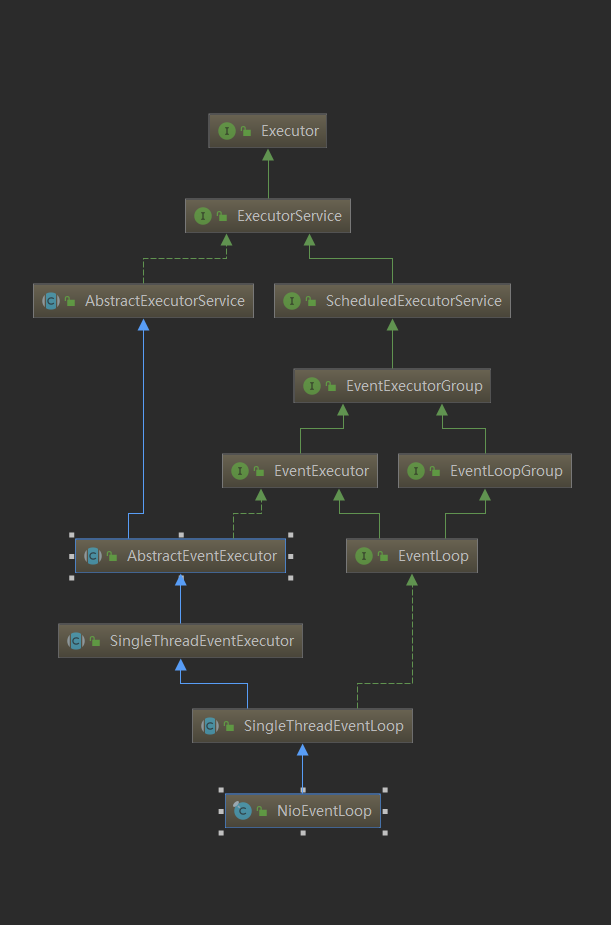问题 :
- NioEventLoop 作用到底是什么?是在哪里用到的?
- NioEventLoop 和我们开头创建的 ServerBootstrap 和 EventLoopGroup 是什么关系 ?
- NioEventLoop 和 NioChannel 怎么传递的(按合理,一个channel应该分配一个NioEventLoop)
- NioEventLoop 工作原理
概述
要知道 NioEventLoop 就必须从 EventLoopGroup 说起,以下是它们的类结构图。
 我们在分析 netty 服务端处理的过程中,有一个 createChannel() 的过程,然后调用 group().next() 方法返回一个 NioEventLoop ,剩下的东西就交给这个 NioEventLoop 来处理了,实际中 EventLoopGroup 包含这一个 NioEventLoop 数组,它们是执行处理的实施者。
我们在分析 netty 服务端处理的过程中,有一个 createChannel() 的过程,然后调用 group().next() 方法返回一个 NioEventLoop ,剩下的东西就交给这个 NioEventLoop 来处理了,实际中 EventLoopGroup 包含这一个 NioEventLoop 数组,它们是执行处理的实施者。
源码分析
EventLoopGroup 的父类 MultithreadEventLoopGroup分析
public abstract class MultithreadEventLoopGroup extends MultithreadEventExecutorGroup implements EventLoopGroup {
private static final InternalLogger logger = InternalLoggerFactory.getInstance(MultithreadEventLoopGroup.class);
private static final int DEFAULT_EVENT_LOOP_THREADS;
//默认EventLoopThreads处理线程数
static {
DEFAULT_EVENT_LOOP_THREADS = Math.max(1, SystemPropertyUtil.getInt(
"io.netty.eventLoopThreads", Runtime.getRuntime().availableProcessors() * 2));
if (logger.isDebugEnabled()) {
logger.debug("-Dio.netty.eventLoopThreads: {}", DEFAULT_EVENT_LOOP_THREADS);
}
}
/**
* @see {@link MultithreadEventExecutorGroup#MultithreadEventExecutorGroup(int, Executor, Object...)}
*/
protected MultithreadEventLoopGroup(int nThreads, Executor executor, Object... args) {
super(nThreads == 0 ? DEFAULT_EVENT_LOOP_THREADS : nThreads, executor, args);
}
/**
* @see {@link MultithreadEventExecutorGroup#MultithreadEventExecutorGroup(int, ThreadFactory, Object...)}
*/
protected MultithreadEventLoopGroup(int nThreads, ThreadFactory threadFactory, Object... args) {
super(nThreads == 0 ? DEFAULT_EVENT_LOOP_THREADS : nThreads, threadFactory, args);
}
@Override
protected ThreadFactory newDefaultThreadFactory() {
return new DefaultThreadFactory(getClass(), Thread.MAX_PRIORITY);
}
@Override
public EventLoop next() {
return (EventLoop) super.next();
}
@Override
protected abstract EventLoop newChild(Executor executor, Object... args) throws Exception;
}
MultithreadEventExecutorGroup 类
public abstract class MultithreadEventExecutorGroup extends AbstractEventExecutorGroup {
//接受到任务,交给children 执行
private final EventExecutor[] children;
private final Set<EventExecutor> readonlyChildren;
private final AtomicInteger childIndex = new AtomicInteger();
private final AtomicInteger terminatedChildren = new AtomicInteger();
private final Promise<?> terminationFuture = new DefaultPromise(GlobalEventExecutor.INSTANCE);
/**
* Create a new instance.
*
* @param nThreads the number of threads that will be used by this instance.
* @param threadFactory the ThreadFactory to use, or {@code null} if the default should be used.
* @param args arguments which will passed to each {@link #newChild(Executor, Object...)} call
*/
protected MultithreadEventExecutorGroup(int nThreads, ThreadFactory threadFactory, Object... args) {
this(nThreads, threadFactory == null ? null : new ThreadPerTaskExecutor(threadFactory), args);
}
/**
* Create a new instance.
*
* @param nThreads the number of threads that will be used by this instance.
* @param executor the Executor to use, or {@code null} if the default should be used.
* @param args arguments which will passed to each {@link #newChild(Executor, Object...)} call
*/
protected MultithreadEventExecutorGroup(int nThreads, Executor executor, Object... args) {
if (nThreads <= 0) {
throw new IllegalArgumentException(String.format("nThreads: %d (expected: > 0)", nThreads));
}
if (executor == null) {
executor = new ThreadPerTaskExecutor(newDefaultThreadFactory());
}
children = new EventExecutor[nThreads];
for (int i = 0; i < nThreads; i ++) {
boolean success = false;
try {
children[i] = newChild(executor, args);
success = true;
} catch (Exception e) {
// TODO: Think about if this is a good exception type
throw new IllegalStateException("failed to create a child event loop", e);
} finally {
if (!success) {
for (int j = 0; j < i; j ++) {
children[j].shutdownGracefully();
}
for (int j = 0; j < i; j ++) {
EventExecutor e = children[j];
try {
while (!e.isTerminated()) {
e.awaitTermination(Integer.MAX_VALUE, TimeUnit.SECONDS);
}
} catch (InterruptedException interrupted) {
Thread.currentThread().interrupt();
break;
}
}
}
}
}
final FutureListener<Object> terminationListener = new FutureListener<Object>() {
@Override
public void operationComplete(Future<Object> future) throws Exception {
if (terminatedChildren.incrementAndGet() == children.length) {
terminationFuture.setSuccess(null);
}
}
};
for (EventExecutor e: children) {
e.terminationFuture().addListener(terminationListener);
}
Set<EventExecutor> childrenSet = new LinkedHashSet<EventExecutor>(children.length);
Collections.addAll(childrenSet, children);
readonlyChildren = Collections.unmodifiableSet(childrenSet);
}
protected ThreadFactory newDefaultThreadFactory() {
return new DefaultThreadFactory(getClass());
}
@Override
public EventExecutor next() {
return children[Math.abs(childIndex.getAndIncrement() % children.length)];
}
...
可以看到构造方法,就是创建多个 child (真正处理的执行者)。其中 newChild 交给子类实现,我们看一下NioEventLoopGroup newChild 的实现。
@Override
protected EventLoop newChild(Executor executor, Object... args) throws Exception {
return new NioEventLoop(this, executor, (SelectorProvider) args[0]);
}
至此,我们摸清了最终“干活”的人就是 NioEventLoop 。
参考资料
无